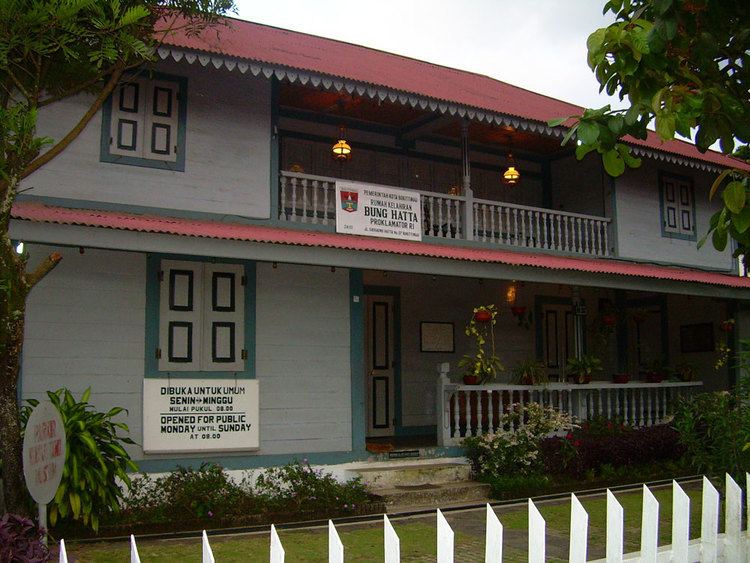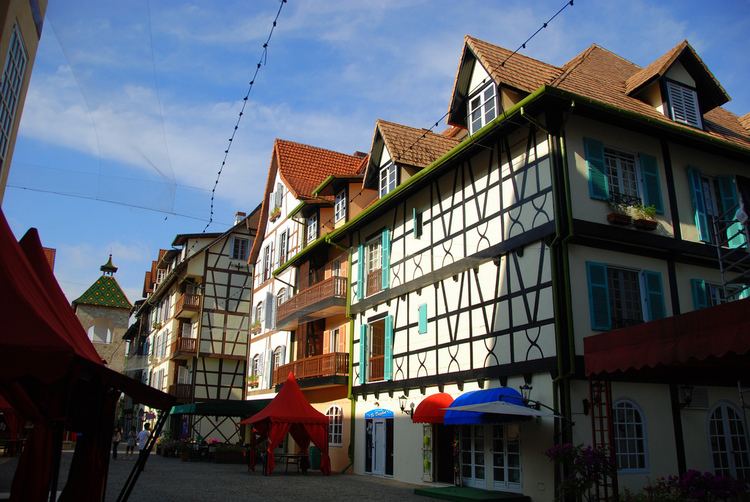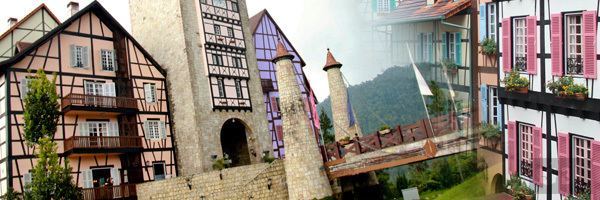Country Area 25.24 km2 | ||
Points of interest Jam Gadang, Lake Maninjau, Lake Singkarak, Mount Merapi | ||
Bukittinggi (Indonesian for "high hill") is the second biggest city in West Sumatra, Indonesia, with a population of over 117,000 people and an area of 25.24 km². It is in the Minangkabau Highlands, 90 km by road from the West Sumatran capital city of Padang. The whole area is directly adjacent to the Agam Regency. It is located at 0°18?20?S 100°22?9?E, near the volcanoes Mount Singgalang (inactive) and Mount Marapi (still active). At 930 m above sea level, the city has a cool climate with temperatures between 16.1° to 24.9°C. The city is the birthplace of some of the founders of the Republic of Indonesia, such as Mohammad Hatta and Assaat.
Contents
- Map of Bukittinggi
- Bukittinggi karbouwengat ngaria sianok september 2010
- History
- Tourism
- Bukittinggi cuisine
- References
Map of Bukittinggi
Bukittinggi was formerly known as Fort de Kock and was once dubbed as Parijs van Sumatera besides of Medan. The city has been the capital of Indonesia during the Emergency Government of the Republic of Indonesia (PDRI). Before it became the capital of PDRI, the city has become the center of government, both at the time of the Dutch East Indies and during the Japanese colonial period.
Bukittinggi is also known as a tourist city in West Sumatera. It is siblings (sister city) with Seremban in Negeri Sembilan, Malaysia. A well-visited tourist spot is the Jam Gadang, a clock tower located in the heart of the city which is also a symbol for the city.
Bukittinggi karbouwengat ngaria sianok september 2010
History

The city has its origins in five villages that served as the basis for a marketplace.

The city was known as Fort de Kock in colonial times in reference to the Dutch outpost established here in 1825 during the Padri War. The fort was founded by Captain Bauer at the top of Jirek hill and later named after the then Lieutenant Governor-General of the Dutch East Indies, Hendrik Merkus de Kock. The first road connecting the region with the west coast was built between 1833 and 1841 via the Anai Gorge, easing troop movements, cutting the costs of transportation and providing an economic stimulus for the agricultural economy. In 1856 a teacher-training college (Kweekschool) was founded in the city, the first in Sumatra, as part of a policy to provide education opportunities to the indigenous population. A rail line connecting the city with Payakumbuh and Padang was constructed between 1891 and 1894.
During the Japanese occupation of Indonesia in World War II, the city was the headquarters for the Japanese 25th Army, the force that occupied Sumatra. The headquarters was moved to the city in April 1943 from Singapore and remained until the Japanese surrender in August 1945.
During the Indonesian National Revolution, the city was the headquarters for the Emergency Government of the Republic of Indonesia (PDRI) from December 19, 1948 to July 13, 1949. During the second Police Action Dutch forces invaded and occupied the city on December 22, 1948, having earlier bombed it in preparation. The city was surrendered to Republican officials in December 1949 after the Dutch government recognized Indonesian sovereignty.
The city was officially renamed Bukittinggi in 1949, replacing its colonial name. From 1950 until 1957, Bukittinggi was the capital city of a province called Central Sumatra, which encompassed West Sumatra, Riau and Jambi. In February 1958, during a revolt in Sumatra against the Indonesian government, rebels proclaimed the Revolutionary Government of the Republic of Indonesia (PRRI) in Bukittinggi. The Indonesian government had recaptured the town by May the same year.
A group of Muslim men had planned to bomb a cafe in the city frequented by foreign tourists in October 2007, but the plot was aborted due to the risk of killing Muslim individuals in the vicinity. Since 2008 the city administration has banned Valentines Day and New Years celebrations as they consider them not in line with Minangkabau traditions or Islam that can lead to "immoral acts" such as young couples hugging and kissing.
Tourism

It is a city popular with tourists due to the climate and central location. Attractions within the city include:

Notable nearby destinations include Lake Maninjau,Lake Tarusan, Kamang Cave, Tarang Cave, and the Harau Valley.
Bukittinggi cuisine
Padang food is the cuisine of the Minangkabau people of West Sumatra, Indonesia. It is among the most popular food in Maritime Southeast Asia. It is known across Indonesia as Masakan Padang (Padang cuisine, in English usually the simpler Padang food) after the city of Padang the capital city of West Sumatra province. It is served in restaurants mostly owned by perantauan (migrating) Minangkabau people in Indonesian cities. Padang food is ubiquitous in Indonesian cities and is popular in neighboring Malaysia and Singapore. The term "Padang food" is often used to designate the whole culinary traditions of Minangkabau people. However, this term is seldom used in Minangkabau inland cities such as Bukittinggi — a culinary hotspot in West Sumatra where they refer to it as Masakan Minang or Minangkabau food, since there are differences between Nasi Padang of Padang and Nasi kapau of Bukittinggi.
Padang food is famous for its rich taste of succulent coconut milk and spicy chili. Among the cooking traditions in Indonesian cuisine, Minangkabau cuisine and most of Sumatran cuisine, demonstrate Indian and Middle Eastern influences, with dishes cooked in curry sauce with coconut milk and the heavy use of spices mixture.
Because most Minangkabau people are Muslims, Minangkabau cuisine follows halal dietary law rigorously. Protein intake are mostly taken from beef, water buffalo, goat, lamb meat, and poultry and fish. Minangkabau people are known for their fondness of cattle meat products including offal. Almost all the parts of a cattle, such as meat, ribs, tongue, tail, liver, tripe, brain, bone marrow, spleen, intestine, cartilage, tendon, and skin are made to be Minangkabau delicacies. Seafood is popular in coastal West Sumatran cities, and most are grilled or fried with spicy chili sauce or in curry gravy. Fish, shrimp, and cuttlefish are cooked in similar fashion. Most of Minangkabau food is eaten with hot steamed rice or compressed rice such as katupek (ketupat). Vegetables are mostly boiled such as boiled cassava leaf, or simmered in thin curry as side dishes, such as gulai of young jackfruit or cabbages.
